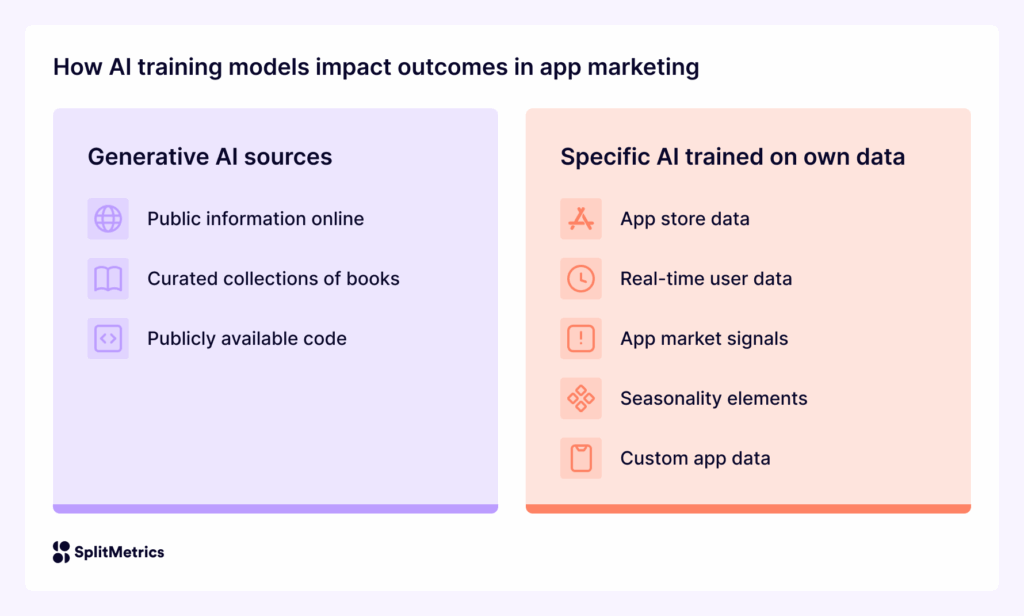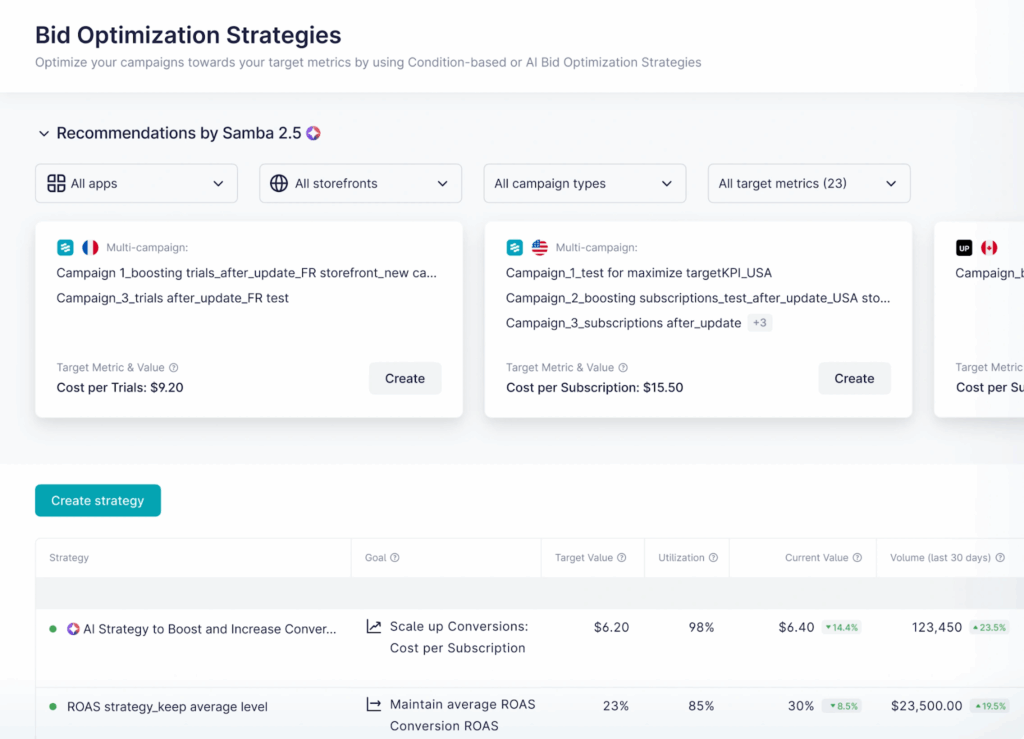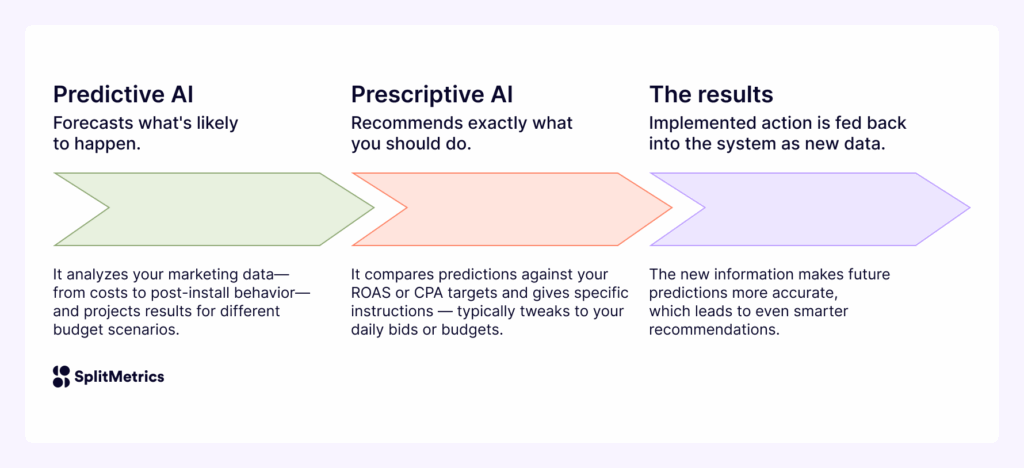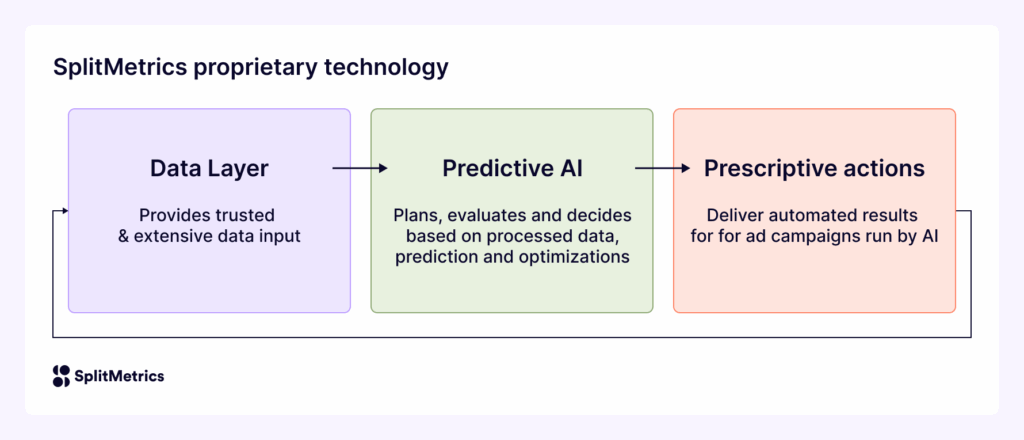While most app marketers are still crafting ChatGPT prompts for ad copy or metadata development, a few are using AI to predict which keywords will drive the highest return three weeks from now.
For app marketers focused on hitting serious growth targets, relying only on generative AI is far from enough.
Why? Because generative AI falls short when dealing with your app data – from user acquisition funnels and campaign performance to in-app engagement and crucial post-install events like ROAS and LTV.
This gap in capability is crucial as AI adoption accelerates. We at SplitMetrics believe that mobile apps will significantly increase their spend on AI tools and systems in the following years. So today we demonstrate how predictive and prescriptive AI can unlock the strategic power within your app’s data to move from simply using AI to winning with AI.
If your job is to drive and scale your app business, you are most likely asking yourself critical business questions such as:
Answering these questions requires an AI type that goes beyond general content production and taps into your most valuable asset: your proprietary app marketing data.
This is your unique, hard-won intelligence: the ad spend data, impressions, user funnel metrics from your MMP, and those crucial post-install events that tell the real story. Generative AI can’t analyze data on the level that mobile apps need if their goal is to get recommendations that directly drive revenue and impact profitability.
To build a true competitive advantage, you need AI that’s trained specifically on your business signals and data patterns.

The core limitation of generative AI is that it cannot see the complex, multi-layered story your performance data tells.
Purpose-built AI (the opposite of general-purpose built models like generative AI) delivers deeper insights.
Sophisticated AI that serves app marketing goals, on the other hand, should deal effectively with complex data for three critical reasons:
Here’s how this works in practice for a typical ad campaign:
Now let’s see how you can make this happen.
If you can build a strong foundation with your proprietary app data, you unlock a new level of strategic capability. You can move beyond asking AI to create and start using it to calculate and command.
This is the domain of predictive and prescriptive AI — two distinct but complementary models that transform your data into a clear roadmap for growth.
This predictive and prescriptive model works conceptually similar to how major ad platforms like Google and Meta work. They use vast amounts of user data to predict the best ad to serve in any given moment and then prescribe a certain action in their real-time auctions.
While the scale is different, this is the identical principle behind SplitMetrics Samba, which applies this data-driven decision-making to optimize the performance of specific app campaigns.
Predictive AI in app marketing uses your historical and real-time app data to forecast future outcomes. It’s the engine that analyzes your unique blend of performance signals to make highly educated guesses about what’s next.
For an app marketer, it means developing specific, crucial forecasts:
An example of this is the SplitMetrics AI Bid Simulator, which uses predictive AI to forecast how different bid amounts will impact key metrics like spend, conversion volume, and CPA. For app marketers, that means they can simulate the outcome of bid changes before committing their budget, turning complex data into a clear, actionable forecast.
With predictive AI, you’re not just reacting to market changes — you’re seeing them coming and positioning yourself to win before your competitors even know what hit them.
Prescriptive AI in app marketing takes the forecasts from predictive AI and recommends specific, optimized actions you should take to achieve your business goals.
Think of it this way: predictive AI gives you a map of what might happen, while prescriptive AI plots the exact route you should take to get where you want to go.
For app marketers, this translates to actionable directives:
When combined, predictive and prescriptive AI work in tandem to continuously improve your campaigns. The prediction identifies a future opportunity (e.g., “this keyword will be highly profitable next week”), and the prescription provides the exact action to capture it (e.g., “increase the bid on this keyword by $0.15”). This approach turns complex data into straightforward actions that deliver real, measurable results.
App marketers can turn these actionable directives into reality using automated bid optimization strategies within SplitMetrics Acquire, as shown in the example below.

Your campaigns get smarter with each dollar spent when predictive and prescriptive AI models work together, creating a feedback loop that actually learns from itself. This process doesn’t just analyze data — it tells you exactly what to do next to boost ROI.

This automation works alongside experts rather than replacing them. It handles the grunt work while amplifying what marketers do best. App marketers still call the shots, bringing the strategic vision that no algorithm can replicate. They provide essential oversight, interpreting results and tweaking the strategy based on broader market trends or brand initiatives that fall outside the model’s data.
Predictive and prescriptive AI sounds impressive in theory, but it only matters when it actually solves real business problems.
SplitMetrics Samba uses both AI models to constantly refine its approach through an ongoing cycle of analysis and adjustment. This system is designed to focus on your unique business targets, whether that’s hitting a specific CPA or maximizing ROAS, through a three-part process:
For you as an app marketer or business owner, this cuts out the massive expense and years of development it would take to build a similar AI system yourself. Skip hiring a data science team — plug your app into Samba and tap into models refined across millions of marketing data points.

App marketers are moving past ChatGPT prompts to discovering what AI can actually do for their bottom line. Generative AI has its purpose and value, but using it alone won’t drive your next growth phase. The real winners will build custom AI systems around their unique customer data.
The path forward lies in leveraging predictive and prescriptive AI to turn your unique business data into a decisive competitive advantage.
It’s time to move from experimenting to executing. Start by auditing your data and defining a clear business objective for an AI system, such as a specific ROAS or CPA target. Then use this to build an AI strategy with clear revenue targets that actually moves your business forward.